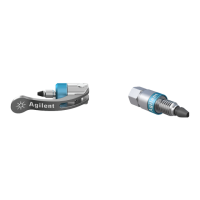Column conditioning
Every column is tested before shipment and shipped
in the test eluent. So, for rst use, rinsing with water is
not necessary. If mobile phase additives are used (such
as buffers or ion-pair reagents) it is advisable to do an
intermediate ush with a mobile phase of the correct
composition, but without these additions. Flushing with
10to 20 column volumes should help in transitioning to your
mobile phase. For shorter chain chemistries (C8, Phenyl, CN,
for example), care should be taken to make sure the column
has been properly equilibrated prior to use. This will ensure
reproducibility and help prevent retention time drifting.
Important safety considerations
• All points of connection in liquid chromatographic systems
are potential sources of leaks. Users should be aware of
the toxicity or ammability of their mobile phases.
• Because of the small particle size, dry column packings
are respirable. Columns should only be opened in a well
ventilated area.
• Please adhere to operating pressure limits noted for
each column (see table). Exceeding these limits will
compromise chromatographic performance and could
beunsafe.
Other operating tips
• While generally not harmful to the column, reverse ow
should be avoided except to attempt removal of clogged
frit (see Column care).
• Always use high purity reagents and chromatography
grade solvent to prepare your mobile phase. Degas and
lter all mobile phase prior to use.
• Disassembling a column will degrade column
performance.













